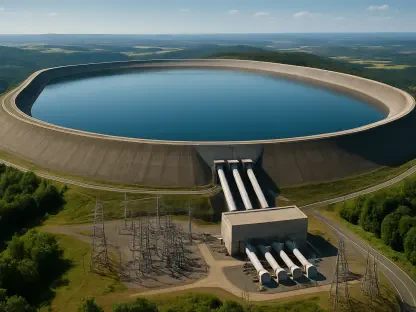House Bill 1579, introduced by state Rep. Anna Novak, R-Hazen, has sparked heated debates and mixed reactions across North Dakota. This bill seeks to place large electricity users, including data centers, under a state-level siting process similar to those that currently apply to power plants and transmission lines. The primary aim of the bill is to alleviate potential strains on North Dakota’s aging and evolving power grid. By ensuring a balance between the influx of new businesses and maintaining a reliable electricity supply, the bill aims to protect consumers from incurring higher electricity rates.
The Scope and Intent of House Bill 1579
House Bill 1579 initially targeted data centers—facilities crucial for artificial intelligence, cloud computing, and cryptocurrency operations. However, the bill has since been expanded to encompass all large power users, increasing the requirement for a state siting permit from facilities using 20 megawatts to those using 50 megawatts of power. This expansion aims to address the growing electricity demand in North Dakota and the potential risks to the grid’s stability.
Data centers represent a significant portion of the increasing electricity demand in North Dakota. Advances in technology, such as an AI model from Chinese company DeepSeek, which claims to require less power, could alter these projections. However, experts, including Etienne Snyman from Applied Digital, a data center operator in southeastern North Dakota, have expressed skepticism about the authenticity and implications of such efficiency improvements. Snyman suggested that, even with efficiency gains, overall power demand will continue to grow, driven by a phenomenon where increased efficiency leads to higher power consumption.
Support and Opposition to House Bill 1579
During testimony, Snyman also supported House Bill 1539, another bill introduced by Novak, which proposes removing Public Service Commission (PSC) siting requirements for on-site backup power generation exceeding 50 megawatts used during power outages. This bill would still necessitate environmental protections and limit its operation to 239 hours annually, ensuring it is not connected to the main power grid. This measure aims to reduce costs and bureaucratic hurdles for data centers known to require uninterrupted power supply to prevent operational disruptions.
The power and data center industries have largely opposed House Bill 1579, fearing it could impede development by introducing additional regulatory uncertainties. Despite efficiency gains, new large power consumers continue to increase electricity demand in North Dakota. Basin Electric Power Cooperative has projected a substantial rise in demand within its nine-state service area, particularly in northwest North Dakota, driven by diverse factors including electrification in the oil industry and new manufacturing operations.
Impact on Consumer Rates and Grid Management
The strain on the power grid has already led to tangible effects on consumer rates. Montana-Dakota Utilities (MDU) attributed a $7.40 monthly rate increase until 2026 to the impact of a 200-megawatt data center in northwest North Dakota, causing grid congestion exacerbated by the regional scarcity of transmission infrastructure following the oil boom. MDU’s legal disputes with the Southwest Power Pool (SPP) over related charges highlight the complexities of grid management and the distribution of responsibility for infrastructure inadequacies. MDU claims that ongoing litigation to address these issues is necessary to protect consumers from future rate hikes.
Alex Vournas, general manager of Mountrail-Williams Electric Cooperative, contested MDU’s assertions, arguing that the utility’s inadequate infrastructure investments following the closure of a nearby coal plant were to blame rather than the data center alone. This dispute reveals underlying tensions between different utility providers and their approaches to managing increasing power demands.
Divided Opinions Among North Dakota PSC Commissioners
The North Dakota PSC is divided on the implications of the emerging power demands. Commissioner Randy Christmann supports the regulation proposed in House Bill 1579, citing the need for systematic planning to prevent unforeseen costs and litigation risks associated with sudden spikes in demand from new large power users. However, Commissioner Sheri Haugen-Hoffart disagrees, viewing the bill as an unnecessary regulatory burden that could hinder North Dakota’s business-friendly environment without clear benefits. Haugen-Hoffart considers the issue with Atlas Power Data Center a one-time incident rather than indicative of a broader, systematic problem.
Industry Concerns and Broader Implications
House Bill 1579, introduced by state Representative Anna Novak, a Republican from Hazen, has ignited intense debates and garnered mixed reactions across North Dakota. The bill proposes to bring large electricity users, such as data centers, under a state-level siting procedure similar to those required for power plants and transmission lines. The primary goal is to address potential pressures on North Dakota’s aging and evolving power grid, which could be exacerbated by the growing demand from new business operations.
The bill aims to create a regulatory framework that ensures a balance between welcoming new business investments and maintaining a stable and reliable electricity supply for existing consumers. By doing this, it seeks to protect residents from facing increased electricity rates due to potential grid strains caused by large-scale electricity consumers. Proponents of the bill argue that it is a necessary step to modernize the state’s infrastructure and safeguard consumer interests, while critics believe it could hinder economic growth by imposing additional regulatory hurdles on incoming businesses. This delicate balance between economic development and infrastructure sustainability is at the core of the ongoing discussions surrounding House Bill 1579.









